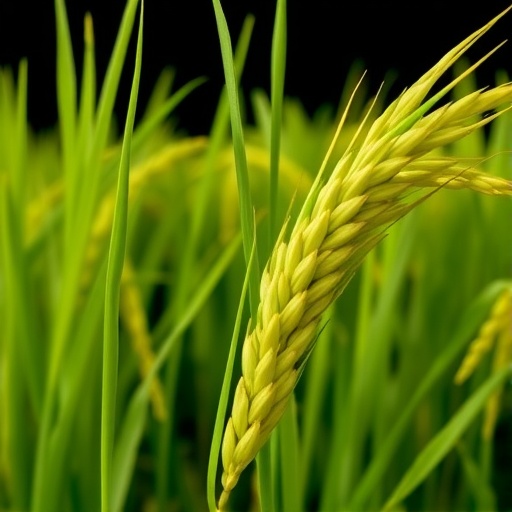In the rapidly evolving field of precision agriculture, accurate crop monitoring stands as a critical challenge for maximizing yield and optimizing resource management. A groundbreaking study, recently published in Plant Phenomics, introduces LKNet—a sophisticated deep learning model ushering in new capabilities for rice panicle counting from UAV imagery. Developed by Song Chen’s research team at the Chinese Academy of Agricultural Sciences, LKNet incorporates large-kernel convolutional architectures along with a novel, optimized loss function, collectively confronting long-standing obstacles in agronomic image analysis such as overlapping targets, annotation bias, and phenotypic variability across growth stages.
Traditional methods for rice panicle counting have typically employed detection-based, density-based, or location-based strategies, each with inherent shortcomings. Detection models often fail to perform adequately in crowded or occluded scenes due to their reliance on individual object identification. Density-based approaches, which convert images into spatial density maps, are prone to degradation caused by complex backgrounds and environmental noise. Location-based models like P2PNet attempt to directly pinpoint panicle centers, offering interpretability and computational simplicity; however, their limited receptive fields and sensitivity to label inaccuracies constrain their robustness in heterogeneous field conditions.
LKNet represents a pivotal evolution from these earlier models by integrating large-kernel convolutional blocks—referred to as LKconv modules—that profoundly expand the network’s receptive field. This architectural innovation allows LKNet to dynamically adjust its perceptual scope according to the spatial scale of rice panicles, which vary considerably with panicle types and phenological stages. Furthermore, the incorporation of a customized localization loss function enhances the model’s tolerance to annotation errors and structural variability, markedly improving counting precision in complex, real-world scenarios.
The comprehensive evaluation of LKNet involved extensive comparative benchmarking across diverse datasets, covering both crowd counting and agricultural domains. Notably, on the challenging ShanghaiTech PartA crowd dataset—characterized by dense and cluttered distributions—LKNet achieved a mean absolute error (MAE) of 48.6 and root mean square error (RMSE) of 77.9, surpassing the original P2PNet and the detection-based PSDNN_CHat framework. On the less dense PartB dataset, LKNet matched state-of-the-art results, showcasing its versatility across varying crowd densities.
Transitioning to crop-specific tasks, LKNet demonstrated exceptional performance in rice panicle counting, exhibiting an RMSE of 1.76 and an R² coefficient of 0.965. This level of accuracy outperformed rival models that excelled in counting larger targets such as maize tassels, underscoring LKNet’s specialized benefits for fine-grained agricultural phenotyping. When applied to UAV-acquired rice canopy images captured at an altitude of seven meters, the model consistently maintained R² values above 0.98 across diverse panicle morphologies—compact, intermediate, and open—evidencing its adaptability to spatial and phenotypic diversity in field conditions.
An observed limitation emerged during later growth stages when increased occlusion and morphological variation introduced some decline in counting accuracy. This phenomenon highlights the inherent complexity of natural crop environments and further emphasizes the necessity for models like LKNet that can dynamically recalibrate their receptive scope and loss parameters in response to evolving scene characteristics.
Ablation studies delved deeper into the architectural contributions of the LKconv backbone, revealing its significant role in elevating both accuracy and computational efficiency. Integration of this backbone reduced RMSE dramatically from 2.821 to 0.846, while also halving the number of model parameters. Among various large-kernel configurations tested, the sequential large-kernel module equipped with an attention mechanism exhibited the highest correlation with ground truth labels, boasting an R² of 0.993. This fusion of attention and large kernels enables the model to capture subtle interrelations and suppress extraneous background features effectively.
The multidisciplinary implications of LKNet extend well beyond academic novelty. By delivering robust and high-throughput panicle counting under a spectrum of phenotypic and environmental variabilities, this model paves the way for scalable UAV-based crop monitoring systems that require minimal manual annotation efforts. This attribute accelerates phenotyping pipelines and cultivates the potential for real-time, field-based decision support in breeding programs and precision farming.
Innovations embedded within LKNet also represent a template for next-generation computer vision methodologies tailored to agriculture. Its dynamic receptive field adaptation and flexible loss formulation address the quintessential challenge of translating image-based predictions into actionable agronomic insights—a longstanding barrier in applying AI to complex biological systems. As such, LKNet exemplifies the ongoing convergence of deep learning, remote sensing, and crop science, signaling a transformative shift toward data-driven agricultural sustainability.
Future directions may explore integrating LKNet with multimodal sensor data, including hyperspectral imaging and environmental metadata, to further refine phenotyping accuracy and contextual understanding. Additionally, scaling the approach across other crop species and geographic zones will be critical to validate generalizability and encourage widespread adoption.
In sum, LKNet stands as a landmark advancement in crop phenotyping technology. By leveraging architectural ingenuity and rigorous validation, it delivers exceptional counting precision and operational efficiency across diverse rice canopy conditions. Emerging from this work is a compelling vision for intelligently automated, UAV-enabled crop monitoring systems poised to revolutionize agricultural research and practice.
Subject of Research: Not applicable
Article Title: LKNet: Enhancing rice canopy panicle counting accuracy with an optimized point-based framework
News Publication Date: 28-Feb-2025
References:
10.1016/j.plaphe.2025.100003
Keywords:
Plant sciences, Technology, Agriculture
Tags: agronomic image analysis advancementsdeep learning for agriculturedensity-based models in agronomyenhancing crop yield through technologylarge-kernel convolutional architecturesLKNet rice panicle countingoptimized loss function in deep learningovercoming annotation bias in agriculturephenotypic variability in crop growthprecision agriculture technologytraditional rice counting methods limitationsUAV imagery in crop monitoring





